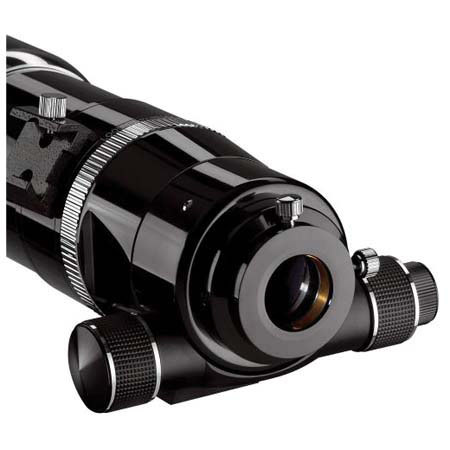
Orders placed during Sukkot (Mon 10/6 after 4PM ET – Wed 10/15) will be shipped Thurs 10/16
View Schedule
Overview
Compare
Protection
Q&A
Questions & Answers
Reviews about this item
Review Summary
About Orion 9927 EON 80mm ED Apochromatic Refractor Telescope
The Orion EON 80mm ED Apochromatic Refractor Telescope incorporates faster optics and all-machined, premium mechanics. The EON 80ED is really an imager's dream scope. The 500mm focal length yields an f-ratio of 6.25, faster than the standard ED80, which is f/7.5. So the EON 80ED gives you brighter images, a wider field of view and allows shorter exposures of deep-sky objects. The 80mm air-spaced doublet lens is crafted with one element of FPL-53 extra-low dispersion, "ED", optical glass, which virtually eliminates the effects of chromatic aberration.
All air-to-glass lens surfaces are fully multi-coated for maximum light throughput. Baffles inside the optical tube, glare threads in the focuser drawtube and a retracting lens shade/dew shield eliminate unwanted glare to deliver crisp, high-contrast images. And the EON 80ED brings 23% more light grasp to the task than the EON 72ED, yet at 15.5" with the lens shade retracted is only 3" longer, so still extremely portable. Like all EON instruments, the 80ED has a beautifully machined Crayford-type 2" focuser with a removable 1.25" insert, allowing use of either 2" or 1.25" accessories. The gearless Crayford design provides smooth, zero image-shift focusing.
The dual-speed focusing knobs have an 11:1 micro-focusing ratio to ensure you achieve the critical focus you need for your images. The focuser is rotatable 360 degrees, allowing comfortable eyepiece positioning or easy image framing when you're taking pictures. A dovetail finder scope base comes standard and accommodates any Orion finder scope or EZ Finder. The telescope has an integrated L-shaped mounting base that fits the dovetail saddle of Orion and Celestron (and some other) telescope mounts. The base also has 1/4"-20 threaded holes to allow attachment to a sturdy field tripod for terrestrial use. With its grab-and-go portability, apochromatic optics and gorgeous "fit and finish," the Orion EON 80mm ED is one terrific telescope. And with a DSLR or astronomical CCD camera attached, it becomes an astrophotographic sensation.
What's in the box:
- Orion EON 80mm ED Refractor OTA
- 2" to 1.25" Eyepiece Adapter
- L-Shaped Dovetail Mounting Base
- Dovetail Finder Scope Base
- Foam-Fitted Hard Carrying Case
- Orion 1 Year Limited Warranty